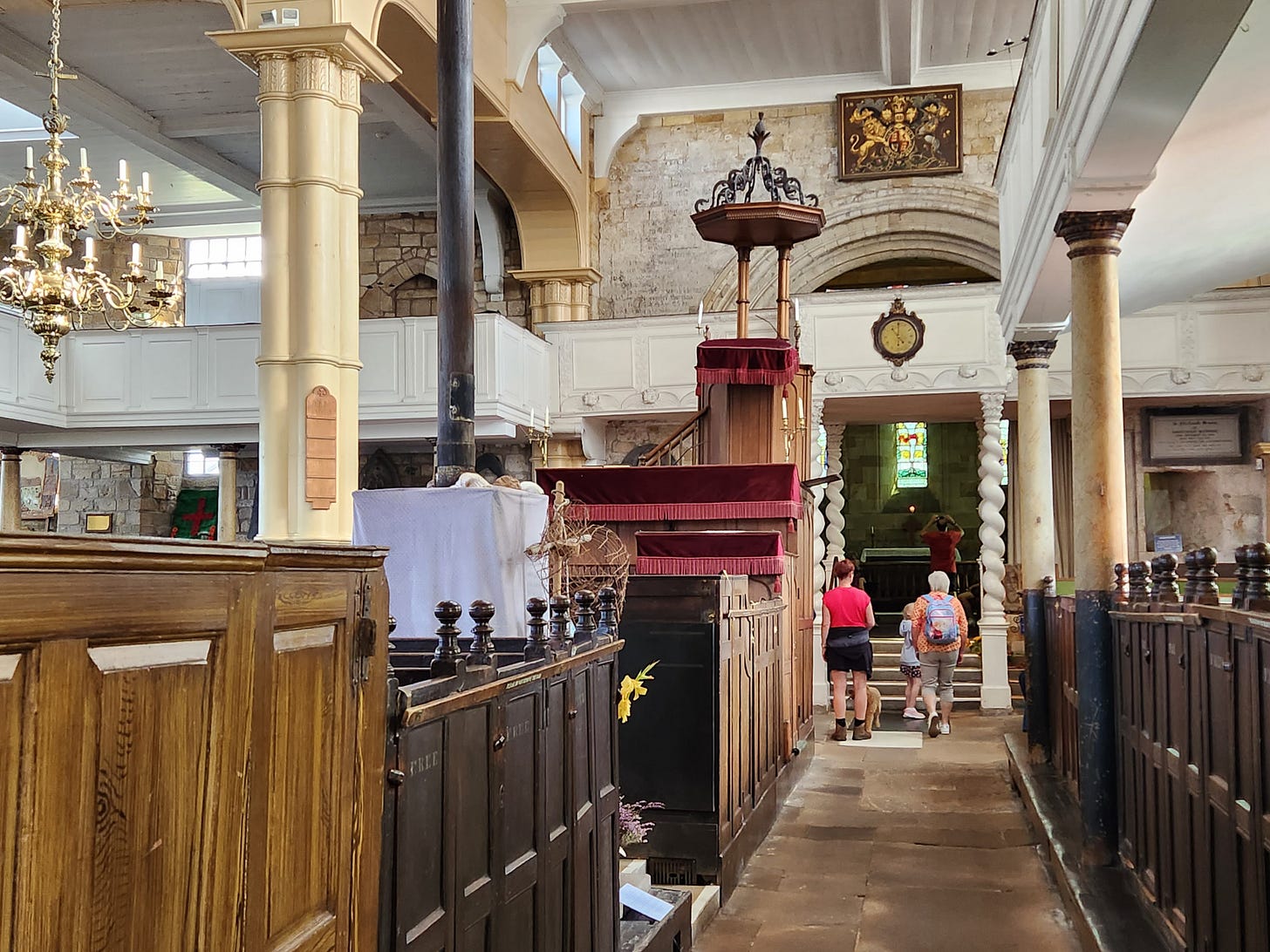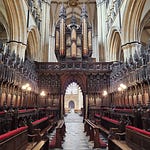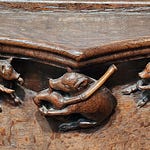The Pulpit and the Lectern.
Two of the most conspicuous pieces of furniture in the naves of our churches are the pulpit and the lectern, yet neither of them is really ancient. They are developments upon different lines of the ambo, the elevated platform with a double flight of steps, from which the epistle and gospel were declaimed in the early church, the acts and martyrdoms of the saints were read and sermons were sometimes delivered. Placed at the entrance of the choir or chancel, this grew into the loft or gallery which surmounted the medieval rood screen on which were often placed desks for the book of the Gospels; and this gallery was anciently called the pulpitum. When the custom arose of reading the lections at the offering of the eucharist within the chancel near the altar itself, desks were provided there for the books, and these lecterns are also known in France as pulpitres.
Stone pulpit at Nantwich, Cheshire, dating from the 14th century. It was next to the rood screen.
In medieval England, a pulpit was by no means universally found as part of the furniture of a church, sermons often being delivered, especially in country churches where the celebrant at mass must frequently have been the preacher also, from the altar; and where they existed there were usually light, movable structures which could be brought out when needed and pushed into some corner out of the way at other times. It is therefore not surprising that very few really ancient examples have survived. At Norwich Cathedral the pulpit was on wheels and was run into a side chapel when not required for us; and a similar custom existed at Christchurch and at St. Patrick's Kilkenny in Ireland. Hereford still preserves its old movable pulpit, and others may be seen at Great St Mary's, Cambridge, and at Christ Church, Streatham.
The honour of possessing the oldest wooden pulpit in England is claimed by Fulbourne, near Cambridge, the example there dating from 1350. At Lutterworth is one probably almost as old, from which it is alleged that Wycliffe preached during his incumbency (1375 to 1384).
17th century pulpit at Ribchester, Lancashire
From the Jacobean period we have received many fine old pulpits, several of them dignified with imposing canopies and sounding boards. St John's church, Leeds, has a very handsome one, as also has St. Michael's at St. Albans. The latter still retains the stand for an hourglass, which in the 17th century, the era par excellence of lengthy sermons, became a necessary addition to its furniture. St. Albans, Wood Street, London has preserved not only the stand, but the hourglass itself. A bracket for this purpose may yet be seen in several other churches, either on the pulpit or on a pillar or a wall nearby. There were advantages in placing the hourglass beyond the preacher's reach, for occasionally in the days of Puritan ascendancy, the vigour of the orator, if not the attention of the hearers, seems to have been almost inexhaustible; and there is a story of a preacher who having seen the last sands of his monitor run out while yet his discourse was in full flood quietly turned it with the remark that there was “yet time to have another glass together” and so started on another hour.
A simple mid-17th century “three-decker” at St Ninian’s, Brougham, Cumbria
Of all strange pieces of ecclesiastical furniture surely the “three-decker” was one of the oddest. This preacher's castle was usually erected in the midst of the church, blocking out chancel and altar from view, and dwarfing everything else in the building. Below was a desk wherein sat the parish clerk, droning responses to the priest, and acting proxy for the whole congregation. Above this rose the desk of the parson, wherein voluminous surplice and flowing bands he read the prayers. On the “upper deck” was the pulpit to which the preacher ascended, after first arraying himself in his black gown.
An extravagant “three decker”, still with tassels and cushions
One smiles to think of the smug satisfaction of that genius who first evolved this precious arrangement from his inner consciousness; how compact the whole structure appeared to him, how eminently convenient! And how successfully, we might add, it strove to make the House of Prayer appear to be nothing but a House of Preaching! Happily this abomination has become a tradition and scarcely more; probably in some obscure corners of the country an example or two may still be found but such as survive are now curiosities indeed.
Pulpits are never mentioned in old inventories of church furniture and property for the reasons already given; in those of the last century and the early years of this, their condition and that of their cushions and the number of tassels thereon seem to have been objects of great solicitude to archdeacons and other ecclesiastical authorities. Pulpits were first ordered to be universally provided in the injunctions of 1547, but they were specially intended then for the reading of the lections at the Eucharist. “In the time of High Mass”, writes Cramner, “he that saith or singeth the same shall read or cause to be read the epistle and the gospel of that Mass in English and not in Latin, in the pulpit or in such convenient places the people may hear the same”. In that same year, the church wardens of St Margaret's Westminster paid the sum of two shillings “for making of the stone in the body of the church for the priest to declare the pistills and the gospells”. This was perhaps a temporary arrangement, for in 1553 they spent 15 shillings in providing “a pulpit where the curate and the clarke did read the chapters at service time.” The first law which definitely assigns the pulpit as the place for the sermon is the 83rd Canon of 1603, which runs as follows": “The Churchwardens or Questmen, at the common charge of the parishioners in every Church shall provide a comely and decent pulpit to be set in a convenient place within the same, by the discretion of the Ordinary of the place, if any question do arise, and to be there seemly kept for the preaching of God's word.”
A very fancy “wineglass” pulpit at All Saints Pavement, York
Much more care was taken to have the people properly instructed in the faith in the medieval church than is sometimes supposed. Two of the Exceprtions of Egbert, Archbishop of York, issued in 750, are to the effect that “on all festivals, and on the Lord’s Day, the priest shall preach the gospel unto the people;” and that “every priest shall, with the greatest diligence, instruct the people committed to his charge in the Lord's Prayer, the Creed and the whole of religion.” In the reign of Æthelred and about the year 994 were promulged Theodulf's Capitula, one of which runs thus: “We exhort every priest to be prepared to teach the people by preaching to them the scriptures, but let him that is ignorant of them at least say this, that they should ‘abstain from that which is evil, and do that which is good,’ and so forth: no priest can excuse himself from teaching, for every one of you has a tongue by which he may reclaim some.” About three centuries later, namely in 1281, Archbishop Peckham issued at Lambeth certain constitutions which give very explicit instructions on the question of preaching. “We decree, he says, that every priest who presides over the people shall four times a year publicly expound to the people in the vulgar tongue, without fantastical subtlety, the fourteen articles of the faith, the ten commandments of the decalogue, the two precepts of the gospel, the seven works of mercy, the seven deadly sins, the seven principal virtues and the seven sacraments of grace.” This, as a scheme of instruction to be used fully every quarter, must, everyone will admit, have been amply sufficient to supply sermons for all the 13 Sundays. Again, in a constitution issued for the Diocese of Sodor in 1350, it is ordered that “all rectors, vicars and chaplains shall on every Sunday and festival carefully expound to their parishioners the word of God, the Catholic faith and the Apostles' Creed in the vulgar tongue.” To quote one more instance only, Arundel, Archbishop of Canterbury, in 1408 gives fresh authority to the injunctions of his predecessor Peckham and orders all priests to counteract the teaching of the Lollards by keeping to the course of instruction laid down by him.
The practice of writing one's sermons and reading them from the manuscript arose towards the end of Henry VIII's reign. It was a troublous time, in which a man was exceedingly liable to “be made an offender for a word.” Some, therefore, preached as little as possible, and others wrote out what they wished to say, so as to ensure the weighing of every expression used. It was to meet such cases, as well as to supply the needs of those who thought themselves unable to preach, that the homilies were written and authorised. The first book, published under Edward VI, contained a dozen discourses written chiefly by Cranmer, Ridley and Latimer. The second book followed in the reign of Elizabeth; it consists of 21 homilies, most of which were composed by Jewel. According to the canons of 1603, every resident parish priest “allowed to be a preacher” must preach “one sermon every Sunday of the year;” which strictly ought to be at the celebration of the Eucharist, since at that service only does the Prayer Book provide for any sermon. Should the “beneficed man,” however, not be in the happy position of being “allowed to be a preacher,” he must procure someone who is so, to address his people at least once a month, and on other Sundays he must read a homily.
The publication of homilies for the use of the less learned clergy was far from being a new expedient. Theodulf's capitula assumed, as in the extract already given, that some priests were unable to preach, and indeed it was but natural that many even of the clergy should have but little education at that date. The bishops therefore composed sermons or homilies in the English or Anglo-Saxon tongue to assist such priests as had need of them.
The lectern is, in its present use, a modern piece of church furniture. In pre-Reformation days there were book stands or lecterns provided in many churches. especially in large and important ones, for supporting the books of the Gospels and the Epistles at Mass; but the lessons or lections at the daily offices are in their present form an outcome of the Reformation, the capitula, or little chapters, of the canonical hours being short passages of one or two verses only.
Lectern at All Saints Pavement, York; this is actually medieval and still used today, though it has required repairs as you can see
The lectern for the Gospels was frequently made in the form of an eagle, on whose outspread wings the book was laid; and from this we have derived the design of so many of our modern lecterns. Merton College, Oxford, has an eagle lectern of the 15th century, as also has St Gregory's Norwich, the latter example being dated 1496. Several handsome lecterns dating from the 17th century are in our cathedrals and in some of our churches. Winchester, Wells, Lincoln, York and Canterbury cathedrals and the parish church of Lynn have brazen eagles of that date. Salisbury has one dated 1719 and Southwell one formerly in Newstead Abbey. The York Eagle was almost the only thing saved, and that with difficulty, from the fire caused in the choir of the Minster by Martin the Madman in 1829.


















Share this post